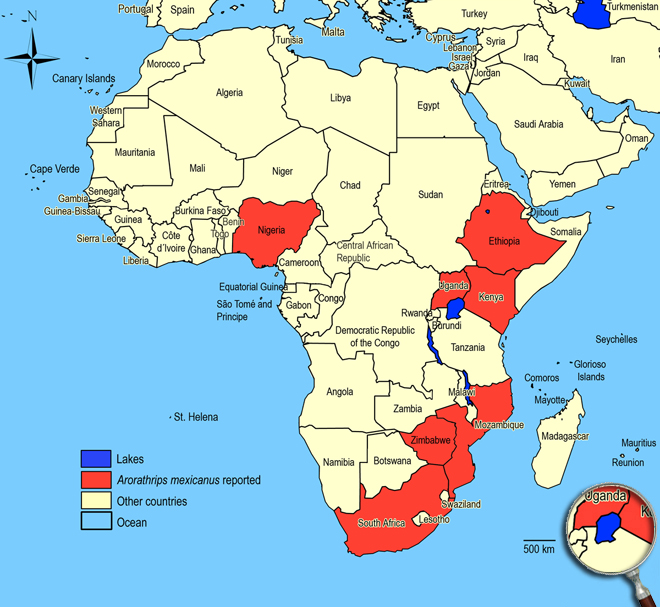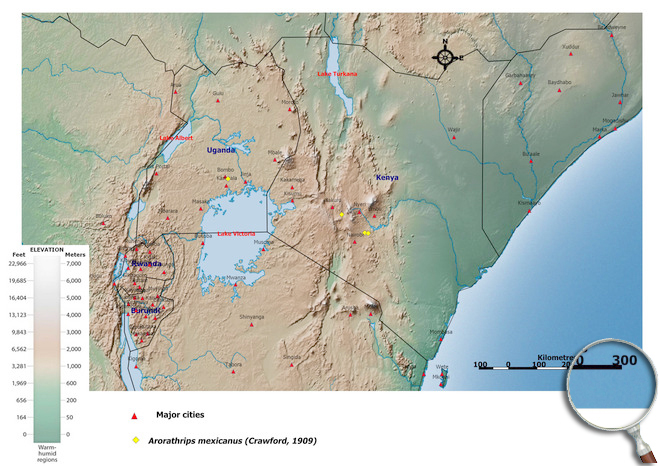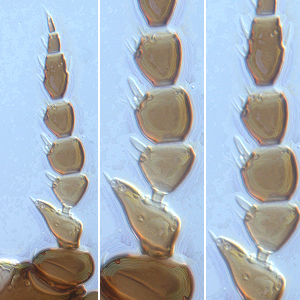Arorathrips mexicanus (Crawford DL, 1909)
Thripinae, Thripidae, Terebrantia, Thysanoptera
Figures
Fig. 1: 8-segmented antenna, segments I-V and segments II-VI (asymmetric pedicel and simple sense cone on segments III and IV)
Fig. 2: Head dorsal with ocellar triangle
Fig. 3: Head ventral with mouthcone and sclerotized ommatidia
Fig. 4: Trapezoidal shape of pronotum
Fig. 5: Meso- and metanotum
Fig. 6: Meso- and metasternum
Fig. 7: Fore wing, distal area of fore wing
Fig. 8: Tergites IV and V
Fig. 9: Sternites VI and VII
Introduction and recognition
Arorathrips mexicanus is a pest of grass-seeds. Female macropterous; dark brown when mature, but teneral individuals with abdomen pale; fore wings light brown with subbase pale. Antennae 8-segmented; segments III & IV with stout simple sense cone, II prolonged on external margin with a terminal sensorium (Fig. 1). Head small and projecting in front of eyes; 3 pairs of ocellar setae, pair III arise in front of ocellar triangle (Fig. 2 and 3). Pronotum trapezoidal with 2 pairs of posteroangular setae (Fig. 4). Metanotum with mainly equiangular reticulations; median pair of setae arise behind anterior margin; campaniform sensilla present (Fig. 5). Meso- and metafurca weakly developed and without median spinula (Fig. 6). Mid and hind tarsi 2-segmented; fore coxae enlarged and transverse; fore femora swollen (Fig. 3); fore tibia extending laterally along external margin of fore tarsus. Fore and hind wings present, more than half as long as abdomen (macropterous) or absent (apterous), fore wing slender and acute at apex; first vein with 2-3 setae on distal half; second vein with 3 of 4 widely spaced setae (Fig. 7). Tergites with many lines of sculpture medially; II-V with transverse row of small tubercles along antecostal ridge (Fig. 8); II-VIII with complete continuous craspedum. Ovipositor weakly developed and without teeth. Sternite VII median posteromarginal setae arise at amrgin (Fig. 9).
Male apterous, body color yellow; sternites III-VII with large circular glandular area medially.
Taxonomic identity
Species:
Arorathrips mexicanus (Crawford DL, 1909)
Taxonomic history
Chirothrips saltensis Tapia, 1952
Chirothrips catchingsi Watson, 1924
Chirothrips floridensis Watson, 1920
Chirothrips mexicanus Crawford DL, 1909
Common name
-
Present taxonomic position
Family: Thripidae Stephens, 1829
Subfamily: Thripinae (Stephens) Karny, 1921
Genus: Arorathrips Bhatti, 1990
Genus description
The genus Arorathrips Bhatti, 1990
Members of this genus were originally included in the genus Chirothrips, and later seperated to it's current generic state by Bhatti (1990) with four species in which the fore tibia is prolonged at its apex around the external margin of the fore tarsus. The generic concept was subsequently extended (Mound & Marullo 1996) to include a total of 15 species, nearly all from the New World and all with the mesothoracic furca greatly reduced. Like species of Chirothrips, members of the genus Arorathrips have a small head, short antennae with 8 segments, antennal segment II mostly expanded laterally, and a trapezoidal pronotum with 2 pairs of elongate posteroangular setae. Moreover, all species of the genus Arorathrips lack multiple setae on the meso- and metanota and on the ventral surface of the head (Mound & Marullo 1996).
Species description
Typical key character states of Arorathrips mexicanus
Coloration and body sculpture
Body color: mainly brown to dark brown, (rare score: distinctively bicolored)
Surface of head, pronotum and fore legs: without obvious or with weakly reticulate sculpture
Antennae
Form of sense cones on antennal segments III and IV: emergent and simple on segments III and IV
Number of antennal segments: 8
Antennal segment I: without any setae on dorsal apical margin
Antennal segment II: without an exceptionally long seta at the inner apex
Antennal segment II shape: asymmetric with prolonged external margin bearing an apical sense area
Antennal segment III shape: symmetric
Length of antennal segment III and IV: antennal segment III similar in length to segment IV
Antennal segment IV and V: without a hyaline ring near the base
Antennal segment VI bears: not a remarkably dagger-shaped sensorium
Head
Distance between bases of ocellar setae III: greater than width of first ocellus
Head: distinctly prolonged in front of compound eyes
Ocellar setae I: present
Ocellar setae III: arising on anterior margin of, or in front of ocellar triangle
Ocelli: present
Length of postocular setae: not alternating short and long setae
Number of ocellar setae: 3
Prothorax
Number of pairs of long anteroangular setae: 0
Number of pairs of long posteroangular setae: 2
Number of pairs of elongate pronotal setae: 2
Pronotal blotch or internal apodeme: absent
Pronotum shape: trapezoidal
Pronotum posteromarginal/posteroangular setae: S2 longer than S3, not equal in length
Mesothorax
Mesosternal furca: without spinula
Metathorax
Metanotal campaniform sensilla: present
Metanotal median setae: S1 behind anterior margin
Metanotum with dominant sculptured triangle medially: absent
Metasternal furca: without spinula
Sculpture of metanotum median area: with mainly equiangular reticulation
Shape of metathoracic furca: transverse, V-shaped
Wings
Fore and hind wings: present, more than half as long as abdomen (macropterous) or absent (apterous)
Fringe cilia arising: from sockets
Fore wing veins: present
Fore- and hind wing surface: covered with microtrichia
Apex of fore wing: with prominent terminal setae
Fore wing anterior margin (costal vein): with setae and cilia but cilia longer than setae
Fore wing costal fringe cilia: arising at anterior margin of wing
Fore wing first vein: distinct from costal vein
Fore wing first vein setal row: incomplete, with setae not closely and uniformly spaced
Fore wing second vein number of setae: 3-4
Fore wing second vein setal row: incomplete, with setae not closely and uniformly spaced
Fore wing shape: mainly parallel sided or margins run continuously towards each other
Fore wing surface: not reticulate
Fore wing first vein number of setae on distal half: 2-3
Fringe cilia on posterior margin near apex: distinctly wavy (undulated)
Length of fore wing costal setae at middle of wing: longer than half of median wing width
Shape of fore wing apex: with mainly posterior margin curved to join anterior margin
Fore wing extreme apex color: dark
Fore wings: uniformly dark or shaded, but with base or sub-base pale
Legs
Fore tibia: prolonged around external margin of fore tarsus
Mid and hind tarsi: with two segments
Color of fore tarsi: pale or yellow, sometimes apical shaded or brown
Abdomen
Pleurotergites: not covered in microtrichia
Sternite II: with marginal setae but no discal setae
Sternites IV, V and VI: with marginal setae but no discal setae
Sternite VII median posteromarginal setae S1: arising at posterior margin
Sternite VII: with marginal setae but no discal setae
Craspedum on tergites IV to VI: present, continuous craspedum
Surface of lateral thirds of abdominal tergites: without regular rows of fine microtrichia
Tergites II to VII median setal pair: no more than 0.3 as long as median length of tergite
Tergites IV and V median setal pair: shorter than distance between their bases
Tergites V to VII: without ctenidia laterally, but sometimes with rows of microtrichia
Tergite VIII ctenidia: without paired ctenidia laterally, sometimes with irregular microtrichia
Tergite VIII posteromarginal comb of microtrichia: absent
Tergite X: not tubular, longitudinally incomplete
Setae on abdominal tergite X: all setae slender

Similar or related species
Similar to the large genus Chirothrips with 8-segmented antennae, antennal segment II expanded laterally, and trapezoidal pronotum with 2 pairs of elongate posteroangular setae. But Arorathrips mexicanus possesses a greatly reduced mesothoracic furca (furcal pits widely separated), the fore tibia is prolonged at its apex around the external margin of the first fore tarsal segment, and tergites II-V with a transverse row of small tubercles along antecostal ridge. Whereas all species of the genus Chirothrips have furcal pits on mesosternum fused in the middle line, the fore tibia is not prolonged around fore tarsal segment, and the sculpture of antecostal ridge on tergites II-V is more or less elongated. Compared to species of Chirothrips, in Arorathrips mexicanus median posteromarginal setae on sternite VII arising at margin, whereas in species of Chirothrips those setae arise in front of posterior margin of sternite VII.
Biology
Life history
As with other thrips species the life cycle from egg to adult is dependent on temperature. The full cycle can take about 15 days (Lewis 1973) to over a month and adults may live for more than one month producing several generations in one year depending on seasonal weather.
Host plants
Grasses-seeds (Poaceae).
Crops: pumpkins, rice, sorghum, tomato.
Weeds: Bidens pilosa, Galinsoga parviflora, Tagetes minuta.
Vector capacity
None identified, but possible mechanical distribution of phytopathogenic fungi and bacteria.
Damage and symptoms
-
Detection and control strategies
-
Additional notes
In this species, an adult female lays a few eggs within the floret of a grass, and the larva and then the pupa develop within this floret. As a result, commercial grass seed production can be decimated. This species is possibly spread as resting life stages within cultivated grass seeds when grasses are transported around the world.
Biogeography
In tropical and subtropical regions. Ethiopia (Sodere), Mozambique (Umbeluzi - southwest of Maputo, Machava - near Maputo),
Nigeria (Samaru),
South Africa (Gauteng: Pretoria, Kameeldrif, Silverton; Limpopo: Entabeni Forest Station - 4500 ft., Pietersburg - 4200 ft., Mokopane - 4500 ft., Zebediela - 3400 ft., Mariepskop - 4500 ft., Satara - Kruger National Park, Modimolle - 4600 ft., Bela Bela, Farm Kalkfontein, Pienaarsrivier - 3700 ft., Nelspruit - 2350 ft.; Mpumalanga: Kaapmuiden - 1350 ft., Nelspruit - 2350 ft.; KwaZulu-Natal: Pongola River east of Ingwavuma, Mposa and Dukuduku Forest),
Uganda, Zimbabwe (Mutare - 3700 ft., Birchenough Bridge).
African countries where Arorathrips mexicanus has been reported

Occurence of Arorathrips mexicanus in East Africa

Please click here for survey sites of all observed thrips species of Kenya, Tanzania and Uganda.
Click here for locations of Arorathrips mexicanus in parts of East Africa.

Bibliography
Ananthakrishnan TN & Daniel AM (1981). Behavioural components in feeding, reproduction and dispersal of the grass seed-feeding thrips Chirothrips mexicanus Crawford. Current Science. 50 (16): 733-735
Ananthakrishnan TN & Thirumalai G (1977). The grass seed infesting thrips Chirothrips mexicanus Crawford on Pennisetum typhoides and its principal alternate host Chloris barbata. Current Science. 46 (6): 193-194
Balu A & Daniel AM (1987). Ecobehavioural and biological studies on two species of seed infesting thrips (Thysanoptera: Insecta). Proceedings of the Indian Academy of Science, B. 96 (1): 23-32
Bhatti JS (1990). On some genera related to Chirothrips (Insecta: Terebrantia: Thripidae). Zoology (Journal of Pure and Applied Zoology). 2 (4): 193-200
Crawford DL (1909). Some Thysanoptera from Mexico and the South I. Pomona College Journal of Entomology. 1 (4): 109-119
Jenser G (1989). Data to the Thysanoptera fauna of Ethiopia. Acta Zoologica Academiae Scientiarum Hungarica. 35 (3-4): 205-210
Lewis T (1973). Thrips: their biology, ecology and economic importance. Academic Press Inc., London Ltd., 349 pp
Lewis T (1997). Thrips as crop pests. CAB International, Wallingford, 740 pp
Moritz G (2006). Thripse. Pflanzensaftsaugende Insekten, Bd. 1, (1. Auflage). Westarp, Hohenwarsleben, 384 pp. ISBN-13: 978 3 89432 891 7
Moritz G, Morris DC & Mound LA (2001). ThripsID - Pest thrips of the world. ACIAR and CSIRO Publishing Collingwood, Victoria, Australia, CDROM ISBN 1 86320 296 X
Moritz G, Mound LA, Morris DC & Goldarazena A (2004). Pest thrips of the world - an identification and information system using molecular and microscopical methods. Centre for Biological Information Technology, University of Queensland, Australia, CDROM ISBN 1 86499 781 8
Moritz G, O'Donnell C & Parrella M (2009). Pest thrips of North America. Centre for Biological Information Technology, University of Queensland, Australia, CDROM ISBN-13: 978 1 86499 940 2
Mound LA & Kibby G (1998). Thysanoptera: An identification guide, (2nd edition). CAB International, Wallingford and New York, 70 pp
Mound LA & Marullo R (1996). The thrips of Central and South America: An introduction (Insecta: Thysanoptera). Memoirs on Entomology, International, Vol. 6. Associated Publishers, Gainsville, 487 pp
Pitkin BR & Mound LA (1973). A catalogue of West African Thysanoptera. Bulletin de ľInstitut Fondamental ďAfrique Noire, Série A. 35 (2): 407-449
Riherd PT (1954). Thrips a limiting factor in grass-seed production. Journal of Economic Entomology. 47: 709-710
Tapia EA (1952). Dos especies de tisanópteros argentinos nuevos para la ciencia. Anales de la Sociedad Científica Argentina. 154 (4): 107-110
Watson JR (1920). New Thysanoptera from Florida - VII. Florida Entomologist. 4 (2): 18-23
Watson JR (1923). Synopsis and catalog of the Thysanoptera of North America. Bulletin of the Agricultural Experiment Station, University of Florida. 168: 1-100
zur Strassen R (1958). Studies in African Thysanoptera, 1. Journal of the Entomological Society of Southern Africa. 21 (2): 333-353
zur Strassen R (1959). Studies in African Thysanoptera, 2. Journal of the Entomological Society of Southern Africa. 22 (1): 174-198
zur Strassen R (1960). Catalogue of the known species of South African Thysanoptera. Journal of the Entomological Society of Southern Africa. 23 (2): 321-367
zur Strassen R (1967). Studies on the genus Chirothrips Haliday (Thysanoptera: Thripidae) with description of new species. Journal of the Entomological Society of Southern Africa. 29: 23-43
zur Strassen R (2006). Checklist of the Thysanoptera (Insecta) of southern Africa. African Entomology. 14 (1): 63-68
----
Web links
Mound´s Thysanoptera pages
Thysanoptera Checklist
ICIPE Thrips survey sites
UNI Halle & Thrips sites
Thrips of California













